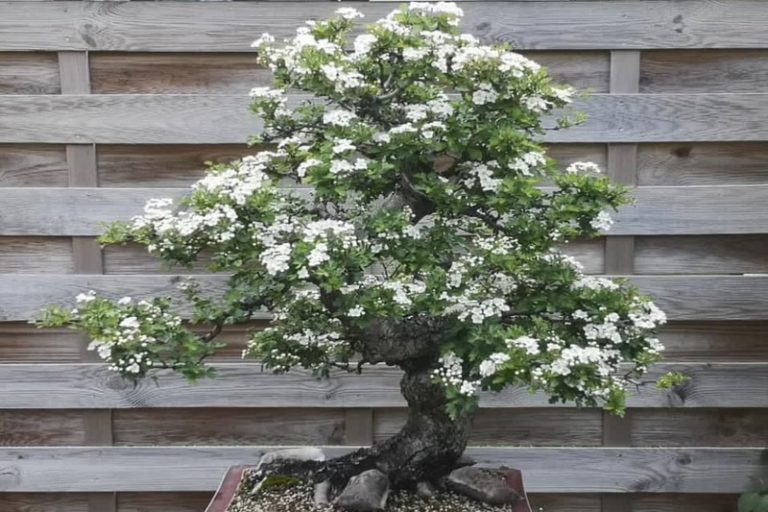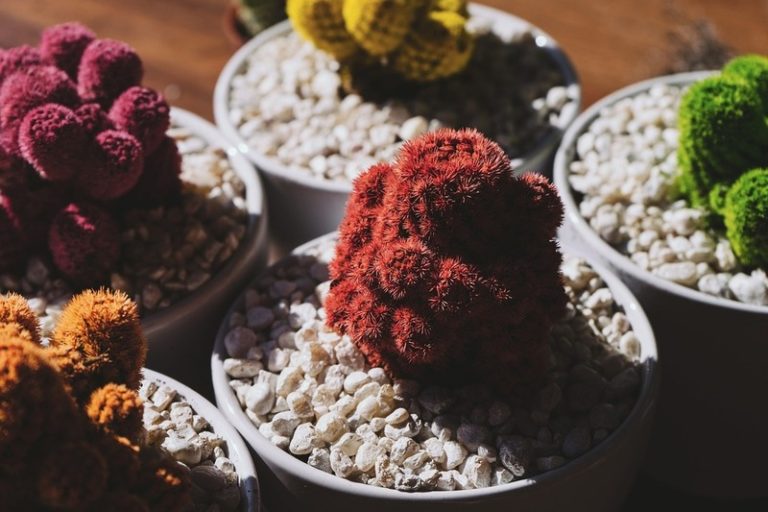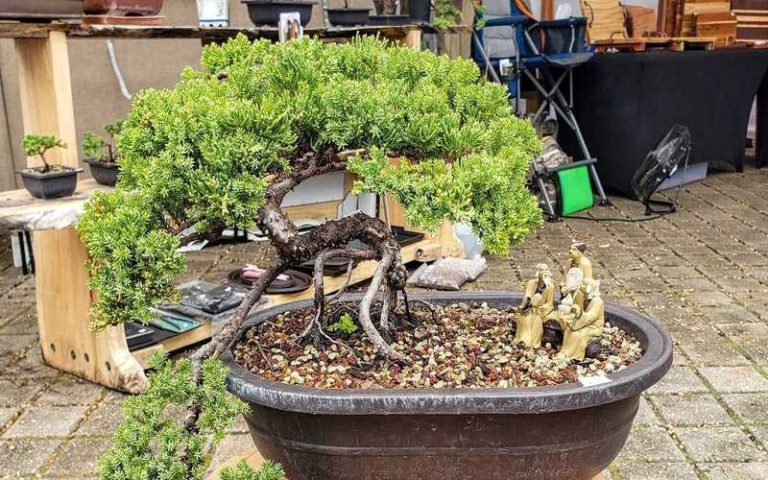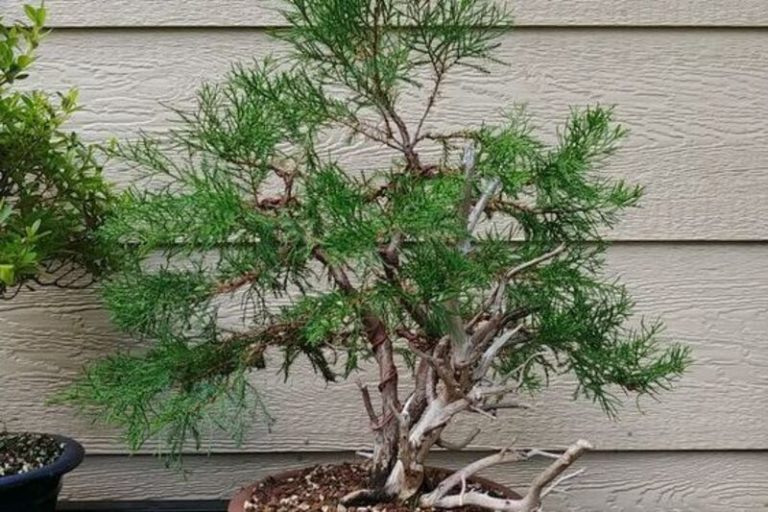Seiju Elm Bonsai: Tiny Trees with Timeless Beauty
Have you ever seen those tiny, beautiful trees that look like they belong in a magical forest? Well, they’re called bonsai, and we’re going to learn about Seiju Elm Bonsai today. Even if you’ve never done this before, don’t worry. We’ll break it down into easy steps so you can enjoy growing your own Seiju Elm Bonsai.
What is Seiju Elm Bonsai?
Seiju Elm Bonsai is a small tree that has been carefully grown to look like a full-sized Seiju Elm tree. It is a type of bonsai art that is known for being small and having fine details. Bonsai fans prune and wire it to make a tiny masterpiece. Taking care of a Seiju Elm Bonsai takes certain skills, which makes it a fun hobby for many people.
History and Origins of the Seiju Elm Bonsai
The history and origins of the Seiju Elm Bonsai are closely tied to the Seiju Elm tree (Ulmus parvifolia ‘Seiju’) and the broader tradition of bonsai itself.
1. Seiju Elm Tree: The Chinese Elm (Ulmus parvifolia) comes in many different kinds, but the Seiju Elm is a unique one. It is thought to have come from China, where it was grown because of its nice qualities, like small leaves and a tight growth habit. Because of these things, it was a good choice for growing bonsai.
2. Bonsai Tradition: The Chinese and Japanese countries have a long history of bonsai, which is the art of growing and shaping small trees. It has been around for more than a thousand years. It was first done by Chinese farmers and students. Later, the Japanese took up the art and made it better, giving it the shape we know today.
3. Introduction of Seiju Elm to Bonsai: Because of its good traits, the Seiju Elm type was brought into the world of bonsai. Horticulturists and people who like bonsai saw that it could be used to make bonsai trees that look nice and are easy to care for. It was a great addition to the art of bonsai because it had small leaves and could be shaped in different ways.
4. Cultivation and Development: Seiju Elm Bonsai has been created and improved over time through careful care, experimentation, and the use of bonsai principles. Bonsai artists and growers started training Seiju Elm trees to make small versions of the grace and beauty of full-grown trees.
5. Modern Popularity: Seiju Elm Bonsai is still a popular choice for people who like bonsai and gather them. People who like bonsai as an art form and a hobby are still drawn to it because of its unique beauty, such as its fine leaves and elegant spreading patterns.
The Seiju Elm Bonsai comes from China and became an important part of the bonsai practice because it grows well as a small tree. It has been formed and improved over many years, making it a favorite among bonsai fans all over the world.
Seiju Elm Bonsai and Their Symbolism
Seiju Elm Bonsai, like many other types of bonsai, can hold symbolic meanings that vary depending on cultural and personal interpretations. Here are some common symbolic associations that people may attribute to Seiju Elm Bonsai:
- Longevity: Bonsai trees, including Seiju Elm Bonsai, are often associated with longevity and a sense of timelessness. The careful and patient nurturing of these miniature trees over many years mirrors the appreciation of life’s enduring qualities.
- Resilience: The Seiju Elm Bonsai, like the Seiju Elm tree itself, can symbolize resilience. These trees are known for their ability to adapt to different environments and conditions, which can be seen as a reflection of human resilience in the face of challenges.
- Balance and Harmony: Bonsai, in general, symbolize the balance and harmony between nature and human intervention. Seiju Elm Bonsai, with their graceful form and aesthetic appeal, can represent the quest for balance and harmony in one’s life.
- Patience and Growth: The process of cultivating and shaping a Seiju Elm Bonsai requires patience and careful attention. This can symbolize the idea that personal growth and development take time, dedication, and continuous effort.
- Miniature Worlds: Bonsai, including Seiju Elm Bonsai, are often described as “miniature worlds.” They can symbolize the idea that beauty and meaning can be found in even the smallest and simplest of things.
- Connection to Nature: Bonsai enthusiasts often feel a deep connection to nature through their trees. Seiju Elm Bonsai, being a representation of a tree in miniature, can symbolize a connection to the natural world and a reminder of the beauty and tranquility found in nature.
- Artistic Expression: Bonsai is considered an art form, and Seiju Elm Bonsai can symbolize artistic expression and creativity. Just as an artist shapes and sculpts their work, bonsai enthusiasts shape and sculpt their trees into living works of art.
It’s important to note that the symbolism of Seiju Elm Bonsai, like all bonsai, can be highly personal. Different individuals may attribute different meanings and significance to these miniature trees based on their own experiences, beliefs, and cultural backgrounds. Ultimately, the symbolism of a Seiju Elm Bonsai is a reflection of the emotions and values that it evokes in the person who cares for and appreciates it.
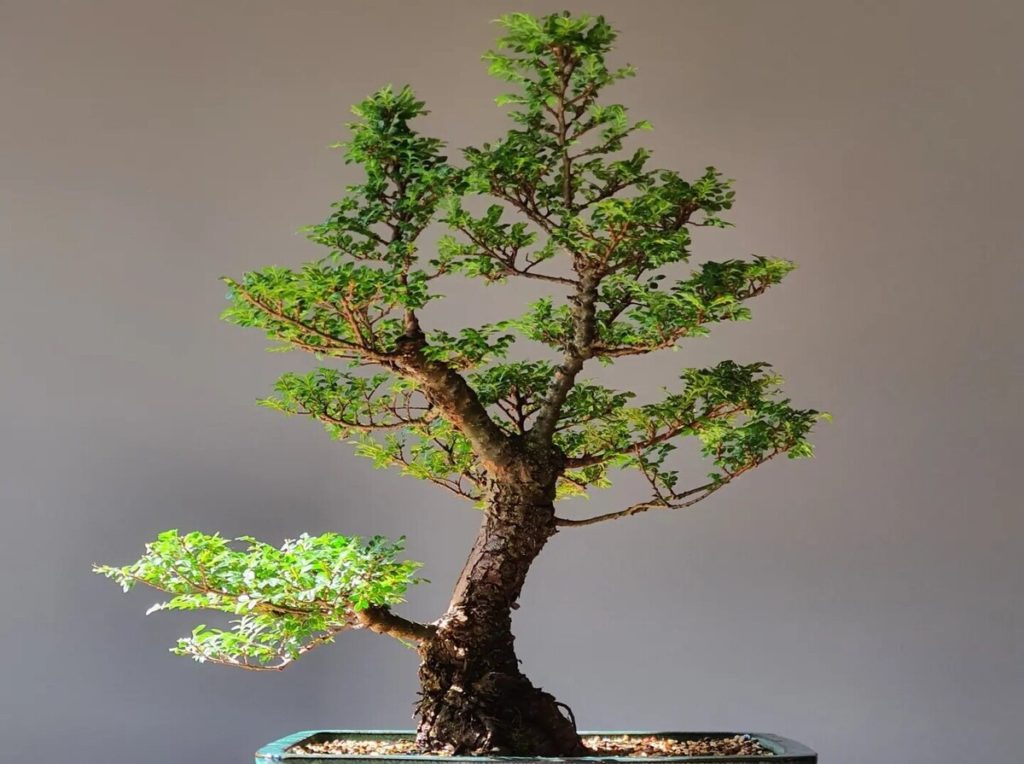
Characteristics of the Seiju Elm Bonsai
Seiju Elm Bonsai, derived from the Seiju Elm tree (Ulmus parvifolia ‘Seiju’), possesses several distinctive characteristics that make it a popular choice among bonsai enthusiasts. These characteristics contribute to its aesthetic appeal and suitability for bonsai cultivation:
Small Leaves: One of the most prominent characteristics of Seiju Elm Bonsai is its small, delicate foliage. These diminutive leaves are esteemed in bonsai because they impart a sense of proportion and equilibrium to the overall appearance of the miniature tree.
Compact Growth Habit: Seiju Elm trees have a naturally compact and dense growth characteristic, which makes them ideal for bonsai cultivation. This development pattern allows bonsai artists to construct proportionate and aesthetically pleasing miniature trees.
Elegant Trunk and Bark: Typically, Seiju Elm bonsai develop graceful, curved trunks with attractive bark textures. These trunks can exhibit a sense of age and personality, enhancing the aesthetic allure of the tree.
Branching Patterns: Seiju Elm trees have bendable branches that can be shaped and trained to create a variety of bonsai designs. These branches can be shaped and arranged by bonsai enthusiasts to achieve the desired aesthetic.
Tolerant of Pruning: In general, Seiju Elm trees are amenable to pruning, which is essential for bonsai cultivation. This tolerance permits the gradual contouring and refinement of the bonsai’s structure.
Year-Round Interest: Seiju Oak Bonsai can provide visual interest throughout the year. In the spring, they produce small, unremarkable flowers, and in the fall, they may have colorful foliage. The branching structure and bark texture remain enticing during the winter months.
Adaptability: Seiju Elm trees can flourish both indoors and outdoors, making them accessible to bonsai enthusiasts from a variety of climates.
Naturalistic Appearance: When skillfully constructed, Seiju Elm Bonsai capture the essence of a mature tree in diminutive form. This authenticity is a defining feature of bonsai aesthetics.
Suitable for Various Styles: Seiju Elm can be used to construct numerous bonsai designs, including formal upright (Chokkan), informal upright (Moyogi), slanting (Shakan), and cascading (Kengai), among others. This adaptability permits artistic expression in bonsai design.
Challenges and Rewards: Seiju Elm Bonsai cultivation can be both difficult and rewarding. The process of shaping and nurturing these trees over time can lead to a profound sense of satisfaction and accomplishment for bonsai enthusiasts.
Seiju Oak Bonsai is distinguished by its small foliage, compact growth habit, elegant trunk and branching, and adaptability. In the realm of bonsai, where it is valued for its aesthetic qualities and suitability for artistic expression, these characteristics contribute to its appeal.
How to Grow a Seiju Elm Bonsai
Growing a Seiju Elm Bonsai can be a rewarding and artistic endeavor. Here are step-by-step instructions to help you cultivate and care for your Seiju Elm Bonsai:
Materials You’ll Need:
Seiju Elm Bonsai Tree (young and healthy)
Bonsai pot with drainage holes
Bonsai soil mix (well-draining)
Pruning shears
Bonsai wire
Humidity tray
Fertilizer for bonsai
Watering can with a fine nozzle
Full-spectrum light source (if growing indoors)
Step 1: Select the Right Seiju Elm Bonsai Tree
- Choose a young Seiju Elm tree whose base and leaves look healthy. The tree should be the right size and style for you.
Step 2: Repot your Bonsai
- Carefully remove the Seiju Elm from its original container, gently shake off excess soil, and prune any excessively long or damaged roots.
- Place the tree in a bonsai pot with well-draining soil. Ensure the roots are spread evenly and the tree is centered in the pot.
- Fill the pot with more soil, pressing it down gently to secure the tree.
- Water thoroughly to settle the soil.
Step 3: Provide Proper Lighting
- Seiju Elm Bonsai thrive in bright, indirect sunlight. Place your bonsai in a location where it receives plenty of indirect sunlight throughout the day.
- If growing indoors, consider using a full-spectrum grow light to supplement natural light.
Step 4: Watering and Humidity Control
- Water your Seiju Elm Bonsai regularly, but allow the top inch of soil to dry out between watering. Use a watering can with a fine nozzle to avoid disturbing the soil.
- Place your bonsai on a humidity tray filled with water and pebbles to maintain adequate humidity levels around the tree, especially in dry indoor environments.
Step 5: Pruning and Wiring
- Prune your Seiju Elm Bonsai to maintain its desired shape. Regularly remove dead or yellowing leaves and trim back overgrown branches.
- Use bonsai wire to gently shape and guide the branches into the desired position. Be careful not to wire too tightly to avoid damaging the tree.
Step 6: Fertilize regularly
- During the growing season (spring through early autumn), fertilize your Seiju Elm Bonsai every 2-4 weeks using a specialized bonsai fertilizer.
- Reduce or stop fertilizing during the winter months when the tree is in a dormant phase.
Step 7: Pest and Disease Management
- Keep an eye out for common pests like aphids and scale insects, as well as fungal diseases. If you notice any issues, treat them promptly with appropriate remedies.
Step 8: Seasonal Care
- Adjust your care routine to the changing seasons. Seiju Elm Bonsai may require more or less water and protection from extreme temperatures, depending on the time of year.
Step 9: Patience and Observation
- A Seiju Elm Bonsai takes a long time to grow. Be patient and watchful as your tree grows, and make changes as needed to keep it healthy and looking good.
Remember that bonsai cultivation is an art form that requires constant care. Your Seiju Elm Bonsai will develop into a gorgeous miniature tree over time, exhibiting the unique charm and elegance of this variety.
Displaying and Showcasing the Seiju Elm Bonsai
Displaying and showcasing your Seiju Elm Bonsai affords you the chance to share the beauty and craftsmanship of your miniature tree with others. Here are some guidelines for effectively presenting your Seiju Elm Bonsai:
Indoor vs. Outdoor Display:
Determine whether you will display your bonsai indoors or outdoors based on the local climate and season. Many bonsai devotees enjoy displaying their plants both indoors and outdoors at various periods.

Bonsai Stand or Table: Place your Seiju Elm Bonsai on a bonsai pedestal or a table with aesthetic appeal. The pedestal or table should complement the manner and design of the bonsai as a whole.
Accent Elements: Consider adding accents such as decorative pebbles, moss, or small figurines to your display to enhance its visual allure. These elements can create a harmonious and natural environment for your bonsai.
Choice of Container: If you choose to exhibit your bonsai indoors, consider positioning it in a decorative container or shallow tray to collect any excess water and provide an aesthetically pleasing base for your tree.
Rotating Display: Rotate your Seiju Elm Bonsai on a periodic basis to promote even growth and sunlight exposure. This will help maintain a proportionate and balanced appearance.
Seasonal Themes: Adjust your display to correspond with the season. For instance, you can use seasonal decorations such as small ornaments or flowers to create ever-changing thematic displays.
Lighting: If exhibited indoors, ensure that your bonsai receives adequate indirect natural light. Consider using full-spectrum grow lamps to provide the necessary light for your tree’s health in indoor displays.
Protective Enclosures: If you are displaying your bonsai outdoors, consider protective enclosures, such as glass or acrylic containers, to safeguard your tree from extreme weather, powerful gusts, and pests.
Showcasing Techniques:
Participate in local bonsai exhibitions and exhibits to showcase your Seiju Elm Bonsai to a larger audience. Follow the exhibition organizers’ guidelines and standards for displaying your bonsai.
Document Your Journey:
Keep a photographic record of the progression and transformation of your bonsai. Develop a portfolio that documents its development and progression over time.
Sharing Online:
Share photos and information about your Seiju Elm Bonsai on social media and bonsai forums in order to communicate with other bonsai enthusiasts and receive feedback and recommendations.
Educational Opportunities:
If you have a passion for bonsai, you may want to offer educational sessions or seminars to share your knowledge and experiences with others interested in bonsai cultivation and artistry.
Remember that displaying your Seiju Elm Bonsai is an opportunity to share your bonsai enthusiasm and the natural beauty of your miniature tree. Customize your display to reflect your personal aesthetic and the distinct nature of your bonsai, and take pleasure in introducing others to this enthralling art form.
How to Care for and Maintain a Seiju Elm Bonsai
Care and maintenance of a Seiju Elm Bonsai require attention to detail and dedication to its health. Follow these care and maintenance guidelines to maintain the health and beauty of your bonsai:
Watering:
- When the top inch of soil feels desiccated to the touch, give your Seiju Elm Bonsai a thorough soaking. To avoid disturbing the soil, use an irrigation can with a narrow nozzle.
- Seasonal variations in watering requirements require vigilance and adaptation. During the growing season (spring to early fall), you will likely irrigate your plants more frequently than during the inert winter months.
Light and Temperature:
- Position your Seiju Elm bonsai in an area that receives indirect, brilliant sunlight. Avoid exposing them to intense, direct sunlight, which can discolor the foliage.
- Maintain the appropriate temperature range. Ideal temperatures for Seiju Elm Bonsai are between 60°F and 75°F (15°C and 24°C). Protect them from heat and chilly extremes.
Pruning and Styling:
- Regularly prune your bonsai in order to preserve its form and dimensions. Remove any dead or yellowing leaves and prune back any overgrown branches.
- Use bonsai wire to delicately shape and guide the branches to achieve your desired aesthetic. Be careful not to wire the tree too tightly, as this can cause damage.
Fertilization:
- During the growing season, from spring to early fall, fertilize your Seiju Elm Bonsai every two to four weeks with a fertilizer formulated for bonsai. Follow the dosage recommendations listed on the fertilizer packaging.
- Reduce or discontinue fertilization during the winter dormancy.
Soil and Repotting:
- Every two to three years, repot your Seiju Elm bonsai to refresh the soil and prevent root bound. Spring is typically the optimal season for repotting.
- Use a bonsai soil mixture that is well-draining and suitable for deciduous trees. Make sure the container has drainage openings to prevent root rot.
Pest and Disease Management:
- Examine your bonsai frequently for common parasites such as aphids, scale insects, and fungal diseases. If you observe any problems, address them immediately with the appropriate remedies, such as insecticidal detergent or neem oil.
Seasonal Adjustments:
- Adapt your maintenance routine to the varying seasons. During the winter, reduce irrigation and move your bonsai to a sheltered location to protect it from frost.
- As new growth emerges in the spring, recommence regular irrigation and fertilization.
Humidity:
- Maintain sufficient humidity around your Seiju Elm bonsai, particularly if it is cultivated indoors. Utilize a humidity tray containing water and pebbles or routinely mist the foliage to increase humidity levels.
Protection from Wind and Extreme Conditions:
- Strong winds can damage the delicate branches and foliage of your bonsai, so protect it from them.
- Consider using protective enclosures or barriers to shield your bonsai from extreme weather conditions if it is kept outdoors.
Patience and Observation:
- Growing and caring for a Seiju Elm Bonsai is a lengthy process. Maintain the tree’s health and vitality by being patient and observant, modifying your care routine as required.
By following to these care and maintenance instructions, you can cultivate a thriving and attractive Seiju Elm Bonsai that will bring you pleasure for years to come. Remember that each bonsai is distinctive, and that it requires consistent attention and care to thrive.
Seiju Elm Bonsai care sheet
| Aspect | Care Tips |
| Watering | Water thoroughly when the top inch of soil feels dry, ensuring water reaches the root zone. |
| Use a watering can with a fine nozzle to avoid soil disturbance. | |
| Adjust the frequency based on the season and climate; more in warm months, less in winter. | |
| Sunlight | Place your Seiju Elm Bonsai in bright, indirect sunlight to ensure healthy growth. |
| Protect it from intense, direct sunlight, which can scorch the leaves. | |
| Temperature | Maintain a moderate temperature range (60°F to 75°F or 15°C to 24°C) for optimal growth. |
| Shield the bonsai from extreme cold or heat, especially during winter and summer heatwaves. | |
| Humidity | Maintain humidity by using a humidity tray with water and pebbles or misting the leaves regularly. |
| Fertilization | Apply bonsai-specific fertilizer during the growing season (spring to early autumn) every 2-4 weeks. |
| Reduce or cease fertilization during the dormant winter months. | |
| Pruning and Trimming | Regularly prune to maintain the desired shape and size, removing dead or yellowing leaves. |
| Trim back overgrown branches to maintain balanced growth. | |
| Wiring and Styling | Use bonsai wire to gently shape and guide branches into the desired positions. |
| Avoid wiring too tightly to prevent injury to the tree. | |
| Repotting | Repot every 2-3 years in spring to refresh the soil and prevent root binding. |
| Ensure the pot has proper drainage to avoid waterlogged roots. | |
| Pest and Disease Control | Regularly inspect for common pests (e.g., aphids, scale) and fungal diseases (e.g., powdery mildew). |
| Treat any issues promptly with suitable remedies (e.g., insecticidal soap, neem oil, fungicides). | |
| Winter Care | Reduce watering during winter but ensure the soil doesn’t completely dry out. |
| Protect the bonsai from frost by moving it to a sheltered location or using frost protection. | |
| Regular Maintenance | Conduct routine checks for overall health and appearance. |
| Adjust care practices based on observations and the specific needs of your Seiju Elm Bonsai. |
This exhaustive care sheet table covers all significant aspects of Seiju Elm Bonsai care, providing guidance for each to help you maintain a healthy and flourishing bonsai tree. Remember that bonsai maintenance requires ongoing observation and adaptation to ensure the health of your tree.
Conclusion
Bonsai cultivation of Seiju Elms is a rewarding hobby. It may take some patience and practice, but with these simple steps, you can create a breathtaking miniature tree that will bring pleasure to your life. So, begin your bonsai voyage today and observe your miniature tree thrive!
FAQ:
Q: What is a Seiju Elm Bonsai?
Ans: A Seiju Elm Bonsai is a miniature tree made from the Seiju Elm (Ulmus parvifolia ‘Seiju’) variety. It is carefully shaped and cultivated in a bonsai container to resemble a full-grown tree in miniature.
Q: How do I water my Seiju Elm Bonsai?
Ans: When the top inch of soil on your Seiju Elm bonsai feels desiccated to the touch, water it. Avoid overwatering or allowing the soil to dry out completely, and ensure that water reaches the root zone.
Q: Can I keep my Seiju Elm Bonsai indoors?
Ans: Yes, your Seiju Elm bonsai can be kept indoors, but it still requires strong, indirect sunlight. Consider the use of grow lamps if natural light is inadequate.
Q: When should I prune my Seiju Elm Bonsai?
Ans: As required, prune your Seiju Elm Bonsai to maintain the desirable shape and size. Remove decaying or yellowing foliage and prune back overgrown branches on a regular basis.
Q: How often should I fertilize my Seiju Elm Bonsai?
Ans: During the growing season (spring to early fall), fertilize your bonsai every two to four weeks with fertilizer designed for bonsai. Reduce or cease fertilization during the winter dormancy.
Q: When should I repot my Seiju Elm Bonsai?
Ans: Spring is the time to repot your Seiju Elm Bonsai every two to three years. This revitalizes the soil and prevents root suffocation. Ensure adequate drainage in the container.
Q: How do I protect my Seiju Elm Bonsai from pests and diseases?
Ans: Inspect your bonsai frequently for aphids and fungal diseases. Utilize appropriate remedies, such as insecticidal detergents or fungicides, to address issues as soon as possible.
Q: What’s the best way to shape and style my Seiju Elm Bonsai?
Ans: Utilize bonsai wire to guide and shape branches into the desired positions. Avoid damaging the tree by avoiding excessively tight wiring.
Q: How can I ensure my Seiju Elm Bonsai survives the winter?
Ans: Reduce irrigation during the winter, but prevent the soil from drying out completely. Move your bonsai to a sheltered location or use frost protection to protect it from frost.
Q: Is it possible to display my Seiju Elm Bonsai in bonsai exhibitions or shows?
Ans: Yes, your Seiju Elm Bonsai can be displayed in exhibitions and displays. Consider sharing your passion and knowledge with other members of the bonsai community and adhere to the rules established by exhibition organizers for displaying your bonsai.
Also Read:


